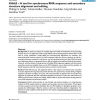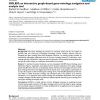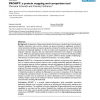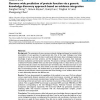BMCBI
2006
13 years 11 months ago
2006
Background: In sequence analysis the multiple alignment builds the fundament of all proceeding analyses. Errors in an alignment could strongly influence all succeeding analyses an...
BMCBI
2006
13 years 11 months ago
2006
Background: The Gene Ontology has become an extremely useful tool for the analysis of genomic data and structuring of biological knowledge. Several excellent software tools for na...
BMCBI
2006
13 years 11 months ago
2006
Background: Comparison of large protein datasets has become a standard task in bioinformatics. Typically researchers wish to know whether one group of proteins is significantly en...
BMCBI
2006
13 years 11 months ago
2006
Background: RNA-dependent gene silencing is becoming a routine tool used in laboratories worldwide. One of the important remaining hurdles in the selection of the target sequence,...
BMCBI
2006
13 years 11 months ago
2006
Background: The automation of many common molecular biology techniques has resulted in the accumulation of vast quantities of experimental data. One of the major challenges now fa...
BMCBI
2006
13 years 11 months ago
2006
Background: In the area of protein structure prediction, recently a lot of effort has gone into the development of Model Quality Assessment Programs (MQAPs). MQAPs distinguish hig...
BMCBI
2006
13 years 11 months ago
2006
Background: The rapidly increasing speed with which genome sequence data can be generated will be accompanied by an exponential increase in the number of sequenced eukaryotes. Wit...
BMCBI
2006
13 years 11 months ago
2006
Background: Gene function analysis often requires a complex and laborious sequence of laboratory and computer-based experiments. Choosing an effective experimental design generall...
BMCBI
2006
13 years 11 months ago
2006
Background: Array-based comparative genomic hybridization (array-CGH) is a recently developed technique for analyzing changes in DNA copy number. As in all microarray analyses, no...




